Utilize “Genome Scissor” CRISPR/Cas9 for signal pathway research - PI3K/AKT case study

Signaling pathways, reflecting the intracellular activities, are a crucial aspect of molecular mechanism research. To explore tumor immunity and targeted research, and to explore the relationship between targets and cell phenotype, CRISPR/Cas9 gene-editing technology can be used to easily clarify the mechanism of action from the perspective of signaling pathways. Today, we will focus on the classic signal pathway of tumor and cancer - PI3K/AKT to introduce three ideas of signal pathway research, helping you get into the right idea and start the experiment in the fastest time to improve the work efficiency!
1) Changes in gene A in cells cause changes in gene B in the signaling pathway
2) The Importance of transduction key gene C in the signaling pathway
3) Study the mutual influence of gene D and gene E in the signaling pathway
[What is a signaling pathway]
When a cell undergoes a certain reaction, molecular signals are continuously transmitted and enter the cell, forming a reaction pathway.
Essentially, it is a summary of the regulatory methods of some molecules that have been thoroughly studied by previous researchers.
Each signaling pathway has its own transduction process and could be interrelated.
[Three major components of a signaling pathway]
l Receptors and ligands: Receptors can transmit extracellular signals and produce specific effects within cells, and ligands can bind to receptors to produce certain physiological effects;
l Protein kinase: A large familiy of enzymes that can transmit information and quickly change the conformation of downstream proteins;
l Transcription factor: A type of proteins that can regulate gene transcription and can initiate the expression of a series of downstream proteins.
[Research ideas - PI3K/AKT case study]
*The PI3K/AKT pathway is closely related to the invasion and metastasis of cancer, and abnormal expression or mutation of related genes can lead to gain or loss of function, leading to tumor cell proliferation.

PI3K/AKT signaling pathway map (Ubigene has off-shelf KO cells for the aforementioned genes)
Ubigene’s KO cell bank also includes PTEN, TP53, TLR2 and more popular KO cell line, covering target cell line A549/Hela/HEK 293... Get the off-shelf KO cells from Ubigene!
Idea 1: Study whether changes in the gene A in cells will affect changes in gene B in the signaling pathway, leading to changes in cell phenotype or function
Case study 1: HIF-1α and Glut-1 are important hypoxic biomarkers and are associated with radiation resistance in laryngeal cancer. Hypoxia activates the PI3K/Akt/mTOR signaling pathway. Researchers selected wortmannin (inhibitor of PI3K) and IGF-1 (agonist of PI3K) to demonstrate drug resistance. As shown in Figure 1A, under normoxic conditions, administration of wortmannin significantly reduced the activity of the PI3K/Akt pathway in laryngeal cancer cell Tu212.
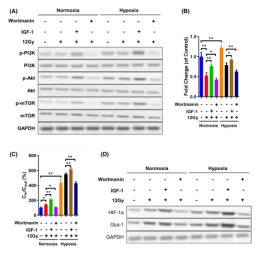
Effect of inhibition of Glut-1 and HIF-1αprotein expression level by PI3K pathway under hypoxic, post-irradiation conditions
Further, CRISPR/Cas9 technology was used to knock out these two genes to investigate whether they contribute to the increase of radiation resistance under hypoxic conditions. During irradiation exposure, single knockout or double knockout of GLUT-1 or HIF-1α further reduced hypoxia-mediated cell proliferation and glucose uptake, and the lowest level was observed in double knockout cells (Figure 2A, B). The results showed the knockout of GLUT-1 or HIF-1α can improve hypoxia-induced radiation resistance. In the xenograft model, wortmannin obviously enhanced the radiation-induced tumor growth inhibition (Figure 3A), resulting in the reduction of tumor volume and weight (Figure 3B, C). Moreover, compared with control mice, knockout of GLUT-1 and/or HIF-1α inhibited tumor growth and improved the radiosensitivity of laryngeal cancer cells.
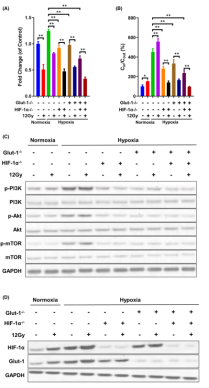
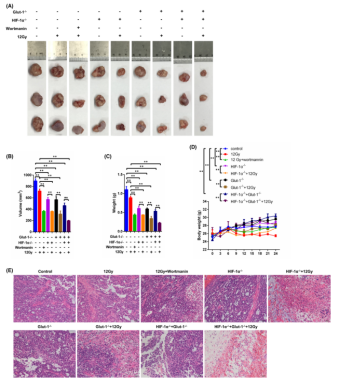
In this study, researchers studied the inhibitors and agonists of PI3K gene family of PI3K/AKT pathway to identify that double knockout of GLUT-1 and HIF-1α in Tu212 cell line can help enhance the radiosensitivity of cells.
Ubigene can provide off-shelf KO cell lines for PI3K gene family to you. Complete KO cells can help you get higher scores on articles!
Ideas 2: Study the role of the transduction key gene C in the signaling pathway
Case study 2: The nonsteroidal anti-inflammatory drug sulfamic acid (SS) has been advocated as a chemopreventive tool before many malignant tumors and a treatment option for malignant tumors. However, the exact molecular drug effect of SS is still not clear. Researchers demonstrated that SS inactivates the PI3K/AKT signaling pathway by activating FOXO3. In thyroid cell line FRTL-5, SS treatment reversed the PI3K/AKT-mediated accumulation of FOXO3 in the cytoplasm and restored its transcriptional activity, and the overexpression of FOXO3 significantly inhibited the growth rate of FRTL-5, further emphasizing the inhibitory effect of FOXO3 on PI3K/AKT. Loss of function of FOXO may be a marker of PI3K/AKT-mediated tumorigenesis.
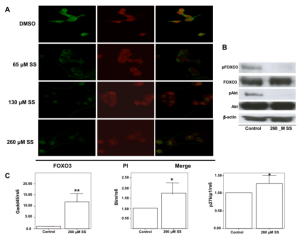

Ubigene can provide custom cell service for interference and overexpression. Outsource the difficult experiments: plasmid construction, virus packaging and cell infection to us, trust in Ubigene supported by thousands of successful cases.
Idea 3: Study the mutual influence of gene D and gene E in the signaling pathway
Case study 3: In order to investigate the role of FOXO3a in the proliferation of lung fibroblasts, FOXO3a was overexpressed and knocked down, and the mouse lung fibroblasts were pretreated with gefitinib to enhance the activity of FOXO3a. The proliferation of lung fibroblasts was detected by CCK8 method, and the expressions of FOXO3a, phosphorylated FOXO3a (p-FOXO3a) and p27 were detected by Western blot. It was found that the proliferation of mouse lung fibroblasts was accompanied by the inactivation of FOXO3a. Knockdown of FOXO3a further decreased the expression of p27 (Figure 5), while overexpression of FOXO3a significantly increased the expression of p27 (Figure 6).
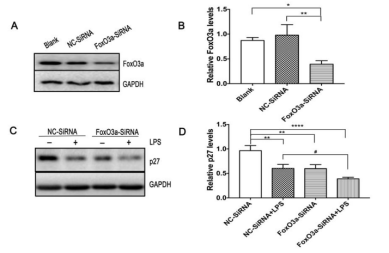
Knockdown of FOXO3a can further reduce the expression of p27 mediated by LPS达
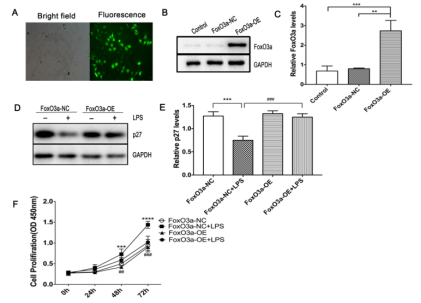
Overexpression of FOXO3a can increase the expression of p27
The prospect of signaling pathway-relying treatment of a variety of diseases is bright, it is known that PI3K/AKT signaling pathway plays a key role in the occurrence and development of tumors. Ubigene has 70+ off-shelf KO cell lines related to PI3K/AKT signaling pathway for you to choose! As low as $1780 each!
Moreover, 3500+ off-shelf KO cell lines are available for your various research needs, covering 27 disease types, 26 signaling pathways, and 5 major categories of drug targets for tumors. Click here to search off-shelf KO cells >>
Express customization service is also available, as fast as 4 weeks, delivering high-quality KO clones which can help shorten your experiment turnaround time. More service details >>
Tips:
[Useful and convenient databases to search information for signal pathways↓↓↓]
KEGG:http://www.genome.ad.jp/kegg/
Nature:pathwayinteraction database
Science:STKE—database of pathway
References
[1]Bao YY, Zhong JT, Shen LF et al. Effect of Glut-1 and HIF-1αdouble knockout by CRISPR/CAS9 on radiosensitivity in laryngeal carcinoma via the PI3K/Akt/mTOR pathway[J]. Journal of Cellular and Molecular Medicine. (2022)26: 2881-2894
[2]Weidinger C, Krause K, Mueller K et al. FOXO3 Is Inhibited by Oncogenic PI3K/Akt Signaling
but Can Be Reactivated by the NSAID Sulindac Sulfide[J]. The Journal of Clinical Endocrinology & Metabolism. 2011, 96(9): E1361–E1371
[3]Gu NN , Xing SP, Chen SH et al. Lipopolysaccharide induced the proliferation of mouse lung fibroblasts by suppressing FoxO3a/p27 pathway[J]. Cell Biology International. 2018, 42(10): 1311–1320














